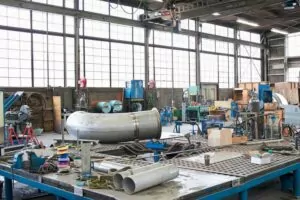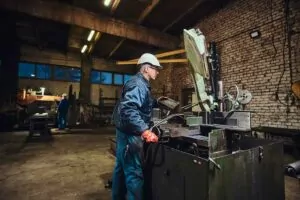Tired arms and aching muscles are a thing of the past with semi-automatic horizontal metal cutting bandsaws. In this article, you’ll learn how innovative features like hydraulic bow-lift systems, automated feeding mechanisms, and intuitive control panels work together to cut down on the physical strain of metal cutting. We’ll break down the technical functions, share real-world performance benefits, and explore best practices to keep operators comfortable and productive.
Understanding Semi-Automatic Horizontal Metal Cutting Bandsaws
Semi-automatic horizontal metal cutting bandsaws are essential tools in various industrial applications, providing a blend of efficiency, precision, and operator comfort. These machines are designed to handle a wide range of materials, from mild steel to more complex alloys, making them invaluable in sectors such as manufacturing, fabrication, and construction. The semi-automatic functionality allows for a more streamlined cutting process, significantly reducing the physical demands placed on operators while enhancing productivity.
Overview of Metal Cutting Applications
Metal cutting bandsaws are utilized across numerous industries, each requiring precision and reliability in their cutting processes. In the fabrication sector, these saws are crucial for producing components that meet strict tolerances, such as brackets, frames, and custom parts. In manufacturing, bandsaws are employed to cut raw materials into manageable sizes for further processing, ensuring that production lines operate smoothly and efficiently.
In construction, horizontal bandsaws are often used to prepare materials like steel beams and pipes, which are essential for structural integrity. The versatility of these machines allows them to perform various cutting tasks, including:
- Cutting large metal sheets into smaller sections for assembly.
- Creating intricate shapes and profiles for specialized applications.
- Batch cutting of multiple pieces to enhance efficiency.
Overall, the ability to achieve precise cuts quickly and consistently makes semi-automatic horizontal metal cutting bandsaws a preferred choice in many industrial settings.
Defining Semi-Automatic Functionality in Horizontal Bandsaws
A semi-automatic bandsaw combines the benefits of manual and fully automatic machines, offering a balance that enhances operational efficiency. Unlike fully manual saws, which require significant physical effort to operate, semi-automatic models utilize hydraulic systems to assist in lifting the saw head after each cut. This feature is particularly beneficial for larger machines, where the weight of the saw head can lead to operator fatigue.
Key components that define the semi-automatic functionality include:
- Hydraulic Bow-Lift Systems: These systems enable the saw head to be raised and lowered with minimal effort, allowing operators to focus on material handling and setup.
- Automated Feeding Mechanisms: These mechanisms ensure consistent feed rates, improving cut quality and reducing the risk of operator error.
- Control Panels: User-friendly interfaces allow operators to set parameters quickly, enhancing the overall cutting process.
This combination of features not only streamlines operations but also significantly reduces the physical strain on operators, making it easier to maintain productivity over extended periods.
Role in Modern Fabrication and Productivity Enhancement
Semi-automatic horizontal metal cutting bandsaws play a pivotal role in modern fabrication environments by enhancing productivity and ensuring high-quality outputs. The integration of automation in these machines leads to several benefits:
- Improved Precision: Automated systems provide consistent cutting speeds and pressures, resulting in more accurate cuts.
- Reduced Operator Fatigue: By minimizing the physical demands of lifting and positioning, these saws allow operators to work longer without experiencing fatigue.
- Enhanced Safety: With automated features, the risk of accidents due to operator error is significantly lowered, contributing to a safer work environment.
In summary, the adoption of semi-automatic horizontal metal cutting bandsaws not only boosts productivity but also fosters a more ergonomic and safer workplace, making them an essential investment for any fabrication operation.
Who knew that metal cutting could be less of a weighty burden? With a hydraulic bow-lift, it’s like your bandsaw is saying, ‘I’ve got your back—literally!’
Ergonomic Challenges in Conventional Bandsaw Operation
Manual Operation and Its Physical Demands
Operating a conventional manual bandsaw requires significant physical exertion from the operator. The repetitive motions involved in lifting the saw head after each cut can lead to fatigue and strain. Operators must frequently bend, twist, and reach to position materials, which can exacerbate discomfort and lead to chronic pain over time. Additionally, the manual handling of heavy workpieces adds to the physical demands, requiring operators to exert considerable force to lift and maneuver materials into place.
For instance, a study published in the Journal of Occupational and Environmental Medicine highlights that workers engaged in manual material handling tasks are at a higher risk of developing musculoskeletal disorders (MSDs) due to the physical strain involved (Bureau of Labor Statistics, 2020). This is particularly relevant in metal cutting operations where the weight of the materials can vary significantly, further complicating the physical demands placed on the operator.
Common Causes of Operator Fatigue in Metal Cutting
Operator fatigue in metal cutting is influenced by several factors, including:
- Sustained Physical Exertion: Continuous lifting and moving of heavy materials can lead to exhaustion.
- Awkward Postures: Operators often adopt uncomfortable positions to reach materials or controls, increasing strain on the back and shoulders.
- Prolonged Periods of Concentration: Maintaining focus during repetitive tasks can lead to mental fatigue, compounding physical tiredness.
- Inadequate Breaks: Insufficient rest periods can prevent recovery from physical exertion, leading to cumulative fatigue.
These factors not only affect productivity but also increase the likelihood of errors, which can have serious safety implications in a workshop environment.
Safety Concerns Associated with Repetitive Manual Tasks
The safety risks associated with manual operation of bandsaws are significant. Repetitive manual tasks can lead to chronic musculoskeletal injuries, particularly in the back, shoulders, and wrists. According to the National Institute for Occupational Safety and Health (NIOSH), these injuries account for a substantial number of workplace incidents, resulting in lost workdays and increased healthcare costs.
Moreover, the physical strain from lifting heavy saw heads and maneuvering large workpieces can lead to accidents, such as slips or falls, especially when operators are fatigued. A case study from the Occupational Safety and Health Administration (OSHA) reported that ergonomic interventions in manual handling tasks significantly reduced injury rates, underscoring the importance of addressing these ergonomic challenges in bandsaw operations.
Mechanisms that Reduce Operator Fatigue
Hydraulic Bow-Lift and Powered Assistance Explained
Hydraulic bow-lift systems are a key feature in semi-automatic horizontal bandsaws, designed to significantly reduce the manual strain on operators. These systems utilize hydraulic cylinders to lift and lower the saw bow, which can be quite heavy, especially in larger machines. When the operator completes a cut, they simply press a button to activate the hydraulic lift, allowing the bow to return to its starting position without the need for physical effort.
This mechanism not only minimizes the risk of injury associated with lifting heavy components but also enhances productivity by reducing downtime between cuts. The hydraulic system operates smoothly, ensuring that the bow is raised and lowered with precision, which contributes to consistent cutting performance.
- Reduced Physical Strain: Operators experience less fatigue as they do not need to manually lift the heavy saw bow.
- Increased Efficiency: The quick return of the bow allows for faster cycle times, improving overall productivity.
- Enhanced Safety: Reducing manual lifting lowers the risk of workplace injuries related to heavy lifting.
- Consistent Performance: Hydraulic systems provide reliable and repeatable movements, ensuring high-quality cuts.
Automated Feeding Systems and Consistent Feed Pressure
Automated feeding systems play a crucial role in maintaining a steady feed pressure during the cutting process. These systems are designed to automatically advance the material into the blade at a controlled rate, which eliminates the need for manual adjustments. By ensuring that the feed pressure remains consistent, these systems help to achieve precise cuts while also reducing the physical demands placed on the operator.
With automated feeding, operators can focus on monitoring the cutting process rather than constantly adjusting the material position. This not only enhances productivity but also minimizes the risk of errors that can occur with manual feeding. For instance, in high-volume production environments, automated systems can significantly reduce the time spent on each cut, allowing for more efficient operations.
Integration of Control Panels for Smooth Cutting Cycles
Integrated control panels in semi-automatic horizontal bandsaws facilitate operational ease and improve cycle consistency. These panels allow operators to set parameters such as cutting speed, feed rate, and blade tension with just a few clicks. By centralizing control in an intuitive interface, operators can quickly adjust settings without needing to leave their workstation, which reduces unnecessary movements and fatigue.
Moreover, modern control panels often feature programmable settings that can be saved for repeated tasks, further streamlining the cutting process. This automation not only enhances the accuracy of cuts but also allows operators to manage multiple tasks simultaneously, thereby increasing overall productivity.
For example, a study by the Fabricators and Manufacturers Association highlighted that companies using advanced control systems reported a 20% increase in operational efficiency due to reduced manual intervention and improved cycle times.
Design Features Enhancing Fatigue Reduction
Structural Rigidity and Stability in Semi-Automatic Designs
Structural rigidity and stability are paramount in the design of semi-automatic horizontal metal cutting bandsaws. Enhanced rigidity minimizes vibrations during operation, leading to smoother cutting processes. This stability not only improves the quality of cuts but also significantly reduces the physical strain on operators. When a machine is stable, operators can focus on their tasks without the distraction of excessive movement or noise, which can contribute to fatigue over time.
Key structural improvements that enhance rigidity and stability include:
- Heavy-Duty Frame Construction: Made from robust materials like cast iron or steel, these frames absorb vibrations effectively.
- Dual Column Design: This design supports the saw head on both sides, providing better balance and reducing flex during operation.
- Precision Ground Components: Components that are precisely machined ensure tight tolerances, which contribute to overall machine stability.
- Integrated Vibration Dampening Systems: These systems are designed to absorb shocks and vibrations, further enhancing operational smoothness.
Precision Blade Guidance Systems and Reduced Vibration
Precision blade guidance systems are critical in semi-automatic horizontal bandsaws, as they ensure that the blade remains aligned throughout the cutting process. This alignment is essential for achieving clean cuts and prolonging blade life. Additionally, these systems work in conjunction with vibration dampening features to minimize operator effort. When vibrations are reduced, operators experience less physical strain, allowing them to work longer without fatigue.
These systems typically include:
- Carbide Blade Guides: These guides provide superior support and alignment for the blade, reducing lateral movement.
- Adjustable Tension Mechanisms: Proper blade tension is crucial for maintaining cutting accuracy and reducing wear.
- Low-Vibration Motors: Motors designed to operate quietly and smoothly contribute to a more comfortable working environment.
Advanced Safety Shields and Emergency Stop Features
Safety is a top priority in the design of semi-automatic horizontal metal cutting bandsaws. Advanced safety shields protect operators from potential hazards, while emergency stop features allow for quick machine shutdown in case of an emergency. These safety measures not only protect operators but also reduce the need for constant manual oversight, which can lead to fatigue. When operators feel secure in their environment, they can focus better on their tasks without the distraction of safety concerns.
Key safety features include:
- Transparent Safety Shields: These shields provide visibility while protecting operators from flying debris.
- Emergency Stop Buttons: Strategically placed buttons allow operators to halt the machine instantly if needed.
- Automatic Shutoff Systems: These systems can detect malfunctions and automatically shut down the machine to prevent accidents.
Operational Best Practices for Minimal Fatigue
Optimizing Cycle Times with Semi-Automatic Operation
Optimizing cycle times is crucial for reducing operator fatigue when using semi-automatic horizontal metal cutting bandsaws. By streamlining workflow strategies, operators can minimize the physical demands of repetitive tasks. Efficient cycle times not only enhance productivity but also allow operators to focus on quality control rather than manual lifting and adjustments.
Key strategies for time efficiency include:
- Batch Processing: Group similar cuts together to reduce setup time and increase throughput.
- Material Handling: Use roller tables or conveyors to facilitate the movement of heavy materials, minimizing manual lifting.
- Automated Settings: Pre-program cutting lengths and speeds to reduce the need for constant adjustments during operation.
- Regular Breaks: Schedule short breaks to prevent fatigue and maintain focus, allowing operators to recharge.
- Ergonomic Workstations: Design workstations that minimize strain, ensuring that controls and materials are within easy reach.
Maintenance Practices to Ensure Consistent Automation
Regular maintenance is essential for ensuring the consistent and efficient operation of semi-automatic bandsaws. Proper upkeep not only prolongs the life of the machine but also enhances its performance, reducing the likelihood of operator fatigue caused by malfunctioning equipment.
Key maintenance practices include:
- Routine Checks: Conduct daily inspections of the blade, hydraulic systems, and electrical components to identify potential issues early.
- Lubrication: Regularly lubricate moving parts to reduce friction and wear, ensuring smooth operation.
- Calibration: Periodically calibrate the machine settings to maintain cutting accuracy and efficiency.
- Blade Replacement: Replace dull or damaged blades promptly to prevent excessive strain on the machine and operator.
- Cleaning: Keep the machine clean from debris and chips to prevent overheating and ensure optimal performance.
Effective Operator Training and Workflow Optimization
Comprehensive operator training is vital for minimizing fatigue and maximizing the efficiency of semi-automatic bandsaw operations. Well-trained operators are more adept at using the machine effectively, which can significantly reduce the physical and mental strain associated with cutting tasks.
Benefits of effective training include:
- Increased Confidence: Operators who understand the machine’s functions are less likely to make errors that can lead to fatigue.
- Improved Safety: Training on safety protocols reduces the risk of accidents, allowing operators to work more comfortably.
- Streamlined Processes: Training can help identify and implement more efficient workflows, reducing unnecessary movements.
- Hands-On Experience: Practical training sessions allow operators to familiarize themselves with the machine, enhancing their skills and reducing anxiety during operation.
- Feedback Mechanisms: Encourage operators to provide feedback on workflow and machine performance, fostering a culture of continuous improvement.
Real-World Performance and Productivity Benefits
Comparative Analysis: Manual vs. Semi-Automatic Bandsaws
When comparing traditional manual bandsaws to semi-automatic models, the differences in efficiency and operator burden become evident. Manual bandsaws require significant physical effort from operators, leading to fatigue and potential safety risks. In contrast, semi-automatic bandsaws incorporate hydraulic systems and automation features that streamline operations. Here are some key differences:
- Operation: Manual bandsaws require operators to lift the saw head after each cut, while semi-automatic models use hydraulic assistance to raise the head automatically.
- Speed: Semi-automatic bandsaws can complete cuts faster due to automated feeding and cutting cycles, reducing overall production time.
- Operator Fatigue: The physical demands of manual operation can lead to fatigue and injury, whereas semi-automatic systems significantly reduce the physical strain on operators.
- Precision: Semi-automatic bandsaws often provide more consistent cutting results due to controlled feed rates and automated adjustments.
- Training: Operators may require less training to operate semi-automatic systems effectively, as they are designed to be user-friendly and intuitive.
Case Studies on Reduced Downtime and Increased Throughput
Several real-world examples illustrate the benefits of adopting semi-automatic horizontal metal cutting bandsaws. For instance, a manufacturing facility that transitioned from manual to semi-automatic bandsaws reported a 30% reduction in downtime. This was primarily due to the elimination of manual lifting and the integration of automated material handling systems. Additionally, throughput increased by 25%, allowing the facility to meet higher production demands without compromising quality.
Another case involved a metal fabrication shop that implemented semi-automatic bandsaws equipped with programmable controls. They experienced a 40% decrease in operator fatigue-related incidents and a 20% increase in overall productivity. The automation features allowed operators to focus on quality control rather than the physical demands of cutting, leading to fewer errors and reworks.
Cost-Benefit Insights and Long-Term Productivity Gains
Investing in semi-automatic bandsaw technology can yield significant long-term benefits. While the initial cost may be higher than manual models, the reduction in operator fatigue and increased efficiency lead to substantial savings over time. For example, a study found that companies using semi-automatic bandsaws saved an average of 15% on labor costs due to decreased physical strain and improved workflow.
Moreover, the longevity of semi-automatic bandsaws, combined with lower maintenance costs and reduced downtime, contributes to a favorable return on investment. Businesses can expect not only to enhance productivity but also to improve employee satisfaction and retention by minimizing the physical demands placed on operators.
Key Insights and Future Trends in Bandsaw Technology
Summary of Fatigue-Reducing Innovations
Recent advancements in bandsaw technology have significantly focused on reducing operator fatigue. Here are some of the most impactful innovations:
- Hydraulic Bow-Lift Systems: These systems allow operators to lift the heavy saw bow with minimal effort, reducing physical strain during repetitive tasks.
- Automated Feeding Mechanisms: Automated systems ensure consistent feed pressure, allowing for smoother cuts and less manual intervention.
- Ergonomic Design Features: Many modern bandsaws incorporate adjustable heights and user-friendly controls to enhance operator comfort.
- Integrated Safety Features: Emergency stop buttons and safety shields help protect operators, reducing anxiety and fatigue associated with safety concerns.
- Smart Technology Integration: Advanced monitoring systems provide real-time feedback on machine performance, allowing operators to focus on quality rather than manual adjustments.
Emerging Automation Trends in Metal Cutting
The metal cutting industry is witnessing a surge in automation trends that promise to enhance efficiency and operator comfort. Key developments include:
Fully automated bandsaws are becoming more prevalent, equipped with features like:
- Digital Control Panels: These panels allow for precise adjustments and monitoring, reducing the need for manual input and oversight.
- Robotic Integration: Robotic arms are being used for loading and unloading materials, minimizing the physical demands on operators.
- Data Analytics: Advanced analytics tools are being integrated to predict maintenance needs and optimize cutting processes, leading to less downtime and improved productivity.
- Remote Operation Capabilities: Some bandsaws now offer remote operation features, allowing operators to manage cutting processes from a distance, further reducing physical strain.
Implications for Future Fabrication Efficiency
The advancements in bandsaw technology are set to revolutionize fabrication efficiency in several ways. Experts predict that:
As automation becomes more integrated, companies can expect:
- Increased Throughput: With reduced operator fatigue and enhanced automation, production rates are likely to rise significantly.
- Lower Operational Costs: Automation can lead to fewer errors and less waste, translating into cost savings over time.
- Enhanced Worker Satisfaction: By minimizing physical strain, companies can improve job satisfaction and retention rates among skilled workers.
- Greater Flexibility: Automated systems can adapt to various cutting tasks, allowing for a more versatile production environment.
- Data-Driven Decision Making: The integration of analytics will enable companies to make informed decisions based on real-time data, optimizing operations further.
Frequently Asked Questions
What makes a semi-automatic horizontal metal cutting bandsaw different from a manual one?
Unlike manual bandsaws that require heavy physical lifting and positioning, semi-automatic models feature hydraulic systems and automated feeders to reduce manual effort and operator fatigue.
How does the hydraulic bow-lift system reduce operator fatigue?
The hydraulic bow-lift system automatically raises and lowers the heavy saw head, significantly lessening the physical burden on the operator after each cut.
What role does the automated feeding system play in minimizing fatigue?
Automated feeding systems ensure a consistent feed rate, reducing the need for constant manual adjustments and thereby easing the operator’s workload.
How do integrated control panels contribute to a less fatiguing operation?
User-friendly control panels allow for quick parameter adjustments without leaving the workstation, cutting down on unnecessary movement and improving overall efficiency.
What safety features are incorporated in these bandsaws to further reduce operator fatigue?
Advanced safety features, including emergency stop buttons and safety shields, help prevent accidents and reduce the stress associated with manual oversight.
How does structural rigidity impact cutting efficiency and operator strain?
A robust, heavy-duty frame minimizes vibrations and enhances cutting precision, meaning operators can work longer with less physical strain.
Are there real-world examples of reduced downtime with semi-automatic bandsaws?
Yes, industry case studies have shown reductions in downtime by up to 30% due to the elimination of manual lifting and streamlined automated processes.
What maintenance practices help ensure these bandsaws continue to reduce operator fatigue?
Routine checks, proper lubrication, and timely calibration of hydraulic and automated systems ensure optimal performance, keeping the machine efficient and less fatiguing to operate.
How do ergonomic design features play a role in lowering musculoskeletal risks?
Ergonomic design, including adjustable workstation setups and ease-of-access controls, minimizes awkward postures and repetitive strain, thereby reducing the risk of musculoskeletal disorders.
What future trends in bandsaw technology could further reduce operator fatigue?
Future trends include enhanced robotic integration, smart monitoring systems, and fully automated features that promise even greater efficiency and further lessen the physical demands on operators.





